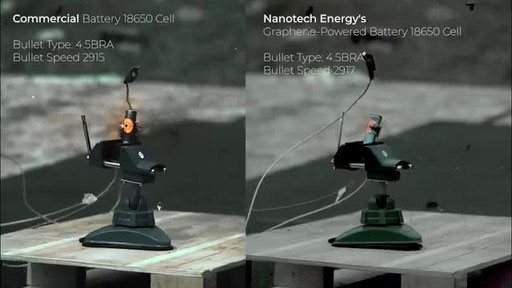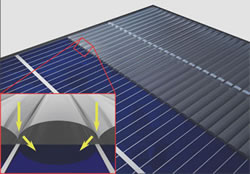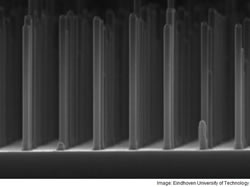The Only Battery That Can Survive a Bullet? Nanotech Energy Shoots for Unprecedented Safety Performance
A Nanotech Graphene-Powered Lithium-Ion Battery 18650 cell was shot by a 4.5BRA bullet at a speed of 2,917 feet per second. Despite the ferocious force of impact, the battery did not catch fire and even still held a charge.
The Evolution of Solar Technology - How Photovoltaic Technology Has Developed and Why Nanotechnology May Influence the Future
Here, Dr Franky So, chief technology officer of nanotechnology research company Nextgen Nano, explains the historical developments of photovoltaic technology and looks to the innovations shaping the years ahead.
SMALL WIND TURBINES FOR THE ENERGY SUPPLY OF THE FUTURE
Small-scale wind energy is still in the beginning phases in Germany. Yet interest in this technology is gaining traction in light of rising electricity prices and the sociopolitical direction we are heading in to invest more in renewable energies in the future.
Atmospheric Ions Harvested for Energy
Atmospheric ions can be harvested as a source of clean, renewable electricity, day and night, through a revolutionary nanomaterial breakthrough called Ion Harvesting Technology, and the author has witnessed it in action.
Solar panels: Nanotechnology gives green energy a green color
American Institute of Physics via Science Daily: Researchers have created green solar panels using soft imprint lithography to print an array of nanocylinders that scatter green light
Capturing Energy with Nanotechnology
One goal of nanotechnology is to improve photovoltaic solar electricity generation. The thermodynamic limit of 80% productivity is well beyond the capabilities of current photovoltaic technologies, whose performance now is only about 43%.
Nano Technology for Hydrogen Production
To reduce our dependence on fossil fuels, it is important to explore different sustainable energy options
Using Nanotechnology to Improve the Efficiency of Solar Cells
Nanostructure-based coating technology provides increased energy efficiency while minimizing costs.
Nanomaterials could double efficiency of solar cells by converting waste heat into usable energy
Devin Coldewey for TechCrunch: An experimental solar cell created by MIT researchers could massively increase the amount of power generated by a given area of panels, while simultaneously reducing the amount of waste heat. Even better, it sounds super cool when scientists talk about it: “with our own unoptimized geometry, we in fact could break the Shockley-Queisser limit.”
The Shockley-Queisser limit, which is definitely not made up, is the theoretical maximum efficiency of a solar cell, and it’s somewhere around 32 percent for the most common silicon-based ones.
You can get around this by various tricks like stacking cells, but the better option, according to David Bierman, a doctoral student on the team (and who is quoted above), will be thermophotovoltaics — whereby sunlight is turned into heat and then re-emitted as light better suited for the cell to absorb. Cont'd...
Cloaking Principle Could Boost Solar Cell Performance
Invisibility cloaking may be a long way from reality, but the principle could help improve the performance of solar cells in the near term.
In a series of simulations, researchers at the Karlsruhe Institute of Technology have demonstrated how cloaks made of metamaterials or freeform surfaces could eliminate shadows cast by energy-harvesting components onto the active surfaces of solar cells.
Contact fingers, which extract electric current, cover up to one-tenth of the surface area of a solar cell. By guiding light around these features, more of the sun's energy could be captured by the solar cell.
"Our model experiments have shown that the cloak layer makes the contact fingers nearly completely invisible," said doctoral student Martin Schumann. Cont'd...
New Material to Increase Solar Cell Efficiency
A team of researchers has come up with a solar cell that produces fuel rather than electricity. A material called gallium phosphide enables the solar cell to produce clean fuel hydrogen gas from liquid water.
To connect an existing silicon solar cell to a battery that splits the water may well be an efficient solution; but it is very expensive.
So, researchers were streamlining their search to a semi-conductor material that is able to both convert sunlight into an electrical charge and split water.
The team found gallium phosphide (GaP), a compound of gallium and phosphide, useful in this respect.
GaP has good electrical properties but the drawback is that it cannot easily absorb light when it is a large flat surface as used in GaP solar cells, said the study thatappeared in Nature Communications.
The researchers overcame this by making a grid of very small GaP nanowires, measuring five hundred nanometres (a millionth of a millimetre) long and ninety nanometres thick.
"That makes these kinds of cells potentially a great deal cheaper," said lead author Erik Bakkers from Eindhoven University of Technology, the Netherlands. Cont'd...
Designer Carbons Are Getting a Boost from Nanotechnology
By Richard Martin for The MIT Technology Review: A group of Stanford researchers have come up with a nanoscale “designer carbon” material that can be adjusted to make energy storage devices, solar panels, and potentially carbon capture systems more powerful and efficient.
The designer carbon that has reached the market in recent years shares the Swiss-cheese-like structure of activated carbon, enhancing its ability to catalyze certain chemical reactions and store electrical charges; but it’s “designed” in the sense that the chemical composition of the material, and the size of the pores, can be manipulated to fit specific uses.
The designer carbon tested at Stanford is “both versatile and controllable,” according to Zhenan Bao, a professor of chemical engineering and the senior author of the study, which appeared in the latest issue of the journal ACS Central Science.
“Producing high-surface-area carbons with controlled chemical composition and morphology is really challenging,” says Bao. Other methods currently available, she says, “are either quite expensive or they don’t offer control over the chemical structure and morphology.” Cont'd...
Records 1 to 12 of 12
Featured Product

Vecoplan - Planning and implementation of complete processing plants in refuse derived fuel production
In order to reduce the costs involved in the energy-intensive production of cement, many manufacturers are turning to refuse-derived fuels (RDF), considerably reducing the proportion of expensive primary fuels they would normally use. Solid fuels are being increasingly used - these might be used tyres, waste wood or mixtures of plastics, paper, composite materials and textiles. Vecoplan provides operators of cement plants with proven and robust components for conveying the material and separating iron and impurities, efficient receiving stations, storage systems and, of course, efficient shredders for an output in various qualities.












